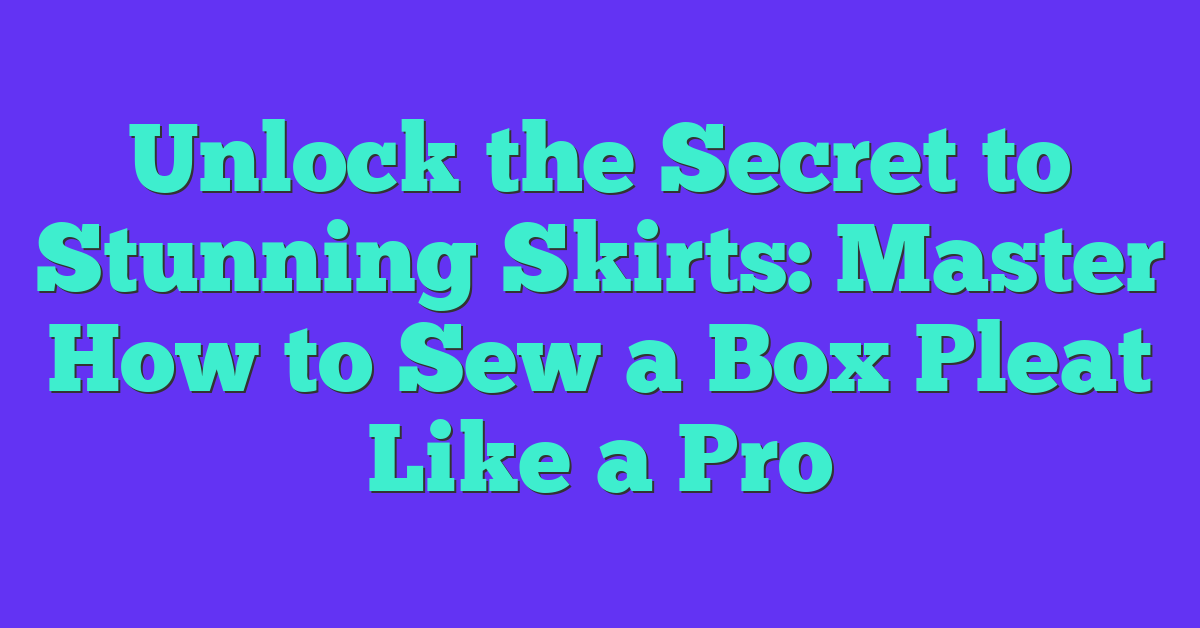Sewing a box pleat can transform a simple skirt into a stunning piece that showcases your style. I love how these structured folds add elegance and flair, making any outfit feel special. Whether you’re a seasoned seamstress or just starting out, mastering this technique can open up a world of creative possibilities.
Tools and Materials Needed
Sewing box pleats requires specific materials and tools for the best results. Gather everything before starting for a smooth process.
Fabric Selection
Select the fabric type based on the skirt’s intended style. Cotton, linen, and lightweight wool work well for structured pleats. Choose medium-weight fabrics for better hold; avoid flimsy materials that won’t hold their shape. Ensure the fabric’s color and pattern align with the desired aesthetic, as this affects the final look of the box pleats.
Sewing Tools
Gather essential sewing tools to make the process efficient. Here’s a list of what I recommend:
- Sewing machine: A reliable sewing machine simplifies the process and speeds up production.
- Fabric scissors: Sharp fabric scissors are crucial for clean cuts without fraying.
- Pins: Use pins to hold pleats in place while sewing.
- Measuring tape: Accurate measurements prevent distortions and errors in pleat size.
- Tailor’s chalk or fabric marker: Mark stitching lines and pleat folds clearly for precise placement.
- Iron and ironing board: Press pleats after sewing to ensure crispness and structure.
- Thread: Choose thread that matches the fabric color for a professional finish.
Having these tools and materials ready makes the box pleat sewing process easier and more efficient.
Preparing the Fabric
Preparing the fabric is a crucial step when sewing box pleats. Ensuring the fabric is ready enhances the accuracy and quality of your pleats.
Measuring and Cutting
Measuring and cutting fabric accurately is essential for well-structured pleats. I start by determining the skirt length, adding seam allowances as needed. Then, I measure the width for the skirt panel based on pleat depth and desired ease. After measuring, I lay the fabric flat, ensuring it’s wrinkle-free, and use a rotary cutter or fabric scissors to cut straight edges. This accuracy helps achieve a polished look.
Marking Pleat Locations
Marking pleat locations helps ensure evenness and precision in the design. I use tailor’s chalk or fabric markers to indicate where each pleat starts and ends. I measure from the waistband down, usually placing the first pleat approximately 2-3 inches from the top. Subsequent marks follow at equal intervals, typically 3-5 inches apart, depending on the desired look. Marking clearly ensures that I sew the pleats consistently, creating a symmetrical and professional finish.
Sewing the Box Pleat
Sewing box pleats adds depth and style to skirts, enhancing their visual appeal. The process requires precision and attention to detail, but it’s rewarding once you see the finished garment.
Creating the Pleats
Creating pleats begins with measuring the fold depth and spacing. I recommend marking the top and bottom of each pleat with tailor’s chalk or fabric markers. Each pleat usually measures about 1-2 inches wide. For every pleat, take a fabric segment equal to the plus height of the pleat from the designated fold line, using an equal amount of fabric on either side to maintain balance.
After marking, fold the fabric right sides together, pin it in place, and check for evenness. It’s important to press each fold with an iron, setting the shape of the pleat securely. This step prevents any unwanted shifting while sewing.
Stitching Techniques
When it comes to stitching, I find that a straight stitch works best for holding pleats in place. Start by sewing from the top edge of the pleat downwards, securing the fabric. Use a seam allowance of about 1/4 inch for a clean finish. For additional support, sew a basting stitch at the top of the pleats, which can be removed later.
Always backstitch at the beginning and end of each seam for durability. After completing the pleating, press the stitched pleats again to set the seams. This step enhances the crispness of the pleats, ensuring they maintain their structure throughout wear.
Finishing Touches
Finishing touches enhance the overall look of your box pleated skirt. Two crucial steps—pressing the pleats and hemming the skirt—ensure a polished and professional appearance.

Pressing the Pleats
Pressing the pleats locks in their shape and provides the crispness essential for a structured look. I start by using a steam iron on a medium heat setting. It’s important to gently press each pleat, working from the top down to avoid distortion. I place a pressing cloth over the pleats to protect the fabric, preventing any shiny marks from the iron. After pressing, I let the pleats cool in place to maintain their crispness. This simple step significantly enhances the garment’s final presentation.
Hemming the Skirt
Hemming the skirt finishes the raw edges and prevents fraying. I measure the desired length from the bottom of the pleats to establish a clean, even finish. I typically fold the hem up by 1 inch, pinning it into place, then I press the fold to create a crisp edge. After ensuring the hem is even all around, I sew it using a straight stitch, keeping the seam allowance about 1/4 inch from the folded edge. For a more discreet hem, I might use a blind hem stitch for a nearly invisible finish. These final steps guarantee that the skirt looks polished and ready to wear.
Conclusion
Sewing box pleats can truly transform your skirts into something special. I love how adding those structured folds not only enhances the style but also gives a professional finish.
With a little practice and attention to detail you can master this technique and create stunning garments that showcase your creativity. Remember to take your time with each step from measuring to pressing.
I can’t wait to see what you create. Happy sewing!

















